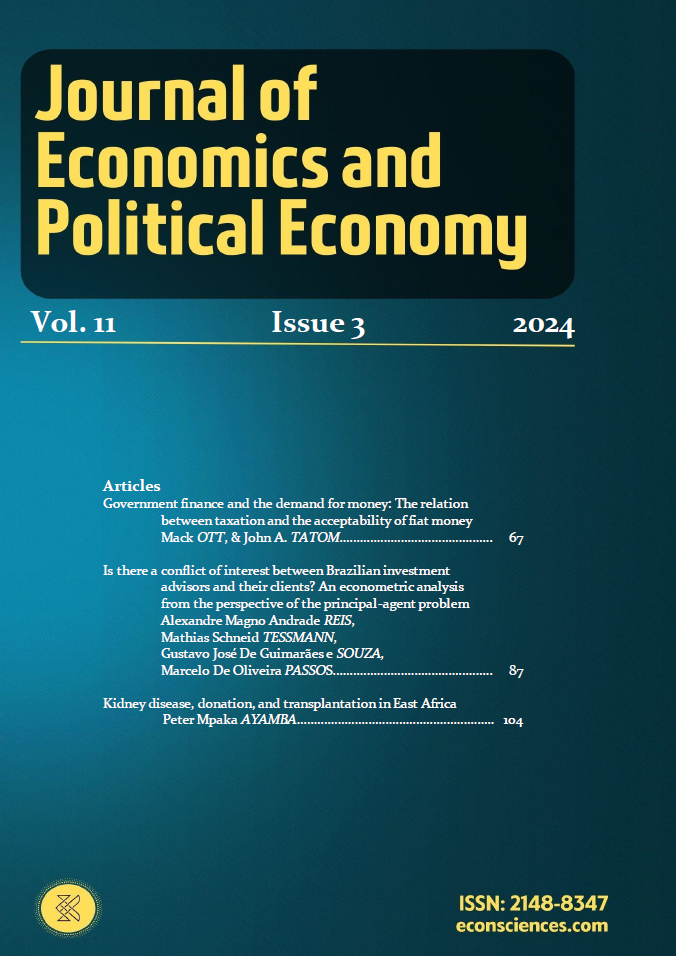Abstract
Requiring taxes to be paid in domestic money provides a valuable characteristic for a state’s money. In the case of a state’s fiat money, it is the foundation for money demand and hence to the development of a financial system built around state money. Except for relatively highly taxed countries, where taxes may encourage tax avoidance and holding bank deposits, the level of taxation is a positive factor boosting financial development. Granger causality tests for 65 countries over the past half-century test the relationship between money and government finance. Except for the low-income countries, where there are only five with adequate data, the causal relationship between taxation and money demand is generally supported in the 60 countries making up the three higher income groups.
Keywords. Higher income groups; Goverment finance; Domand for Money; Taxation.
JEL. L82; L32; D73.
References
Barro, R. (1995). Inflation and economic growth. Bank of England Quarterly Bulletin, May, pp.166-75.
Barro, R. (1996). Inflation and growth. Federal Reserve Bank of St. Louis Review, 48(3), 153-69.
Beim, D.O., & Calomiris, C.W. (2001). Emerging Financial Markets, Boston: McGraw-Hill Irwin.
Bell, S.A., & Nell, E.J. (2003). The State, the Market and the Euro. Cheltenham, UK: Edward Elgar.
Bordo, M.D., & Jonung, L. (1981). The long run behavior of the income velocity of money in five advanced countries, 1870-1975: An institutional approach. Economic Inquiry 19(1), 96-116. doi. https://doi.org/10.1111/j.1465-7295.1981.tb00605.x
Cagan, P. (1956). The monetary dynamics of hyperinflation, in Milton Friedman, (Ed.) Studies in The Quantity Theory of Money, (pp.25-117), Chicago: University of Chicago Press.
Cagan, P. (1958). The demand for currency relative to total money supply. Journal of Political Economy, 66(1), 303-29. doi. https://doi.org/10.1086/258056
DeSoto, H. (2000) The Mystery of Capital, New York: Basic Books.
Feige, E.L. (1989). The Underground Economy, Cambridge: Cambridge University Press.
Feige, E.L. (1994). The underground economy and the currency enigma, in Werner W. Pommerehne (ed.), Public Finance and Irregular Activities, supplement to Public Finance 49, 119-136.
Friedman, M. (1956). The quantity theory of money— A restatement, in Friedman, (Ed.), Studies in the Quantity Theory of Money, Chicago: University of Chicago Press.
Goldberg, D. (2012). The tax-foundation theory of fiat money, Economic Theory, 50, 489-497. doi. https://doi.org/10.1007/s00199-010-0564-8
Goodhart, C. (1998). The two concepts of money: Implications for the analysis of optimal currency areas, European Journal of Political Economy, 14(3), 407-432. doi. https://doi.org/10.1016/S0176-2680(98)00015-9
Hill, R., & Kabir, M. (2000). Currency demand and the growth rate of the underground economy in Canada, 1991-1995. Applied Economics, 32, 183-192. doi. https://doi.org/10.1080/000368400322877
Kesselman, J.R. (1993). Evasion effects of changing the tax mix. The Economic Record, 69(2), 131-148. doi. https://doi.org/10.1111/j.1475-4932.1993.tb01809.x
Keynes, J.M. (1990). A Treatise on Money, London: Macmillan.
Knapp, G.F. (1924). The State Theory of Money, London: Macmillan. An English translation based on the fourth edition of the original 1905 German work.
Kovenock, D., & DeVries, C.G. (2002). Fiat exchange in finite economies. Economic Inquiry 40(2), 147-157. doi. https://doi.org/10.1093/ei/40.2.147
Lerner, A. (1947). Money as a creature of the state. American Economic Review, 37(2), 312-317.
Levine, R. (1997). Financial development and economic growth. Journal of Economic Literature, 35(2), 688-726.
McKinnon, R. (1973). Money and Capital in Economic Development, Washington D.C.: Brookings Institution.
North, D. (1990). Institutions, Institutional Change, and Economic Performance, Cambridge: Cambridge University Press.
Ott, M., & Tatom, J.A. (2006). Money and taxes – The relationship between financial sector development and taxation, paper presented at the Association for Private Enterprise Education meetings, April 2002 in Cancun, and Networks Financial Institute Working Paper, No.2006-WP-09, September.
Roubini, N., & Sala-I-Martin, X. (1992). Financial repression and economic growth. Journal of Development Economics 39(1), 5-30. doi. https://doi.org/10.1016/0304-3878(92)90055-E
Roubini, N., & Sala-I-Martin, X. (1995). A growth model of inflation, tax evasion and financial repression. Journal of Monetary Economics, 35(2), 275-301. doi. https://doi.org/10.1016/0304-3932(95)01192-Q
Selden, R.T. (1956). Monetary velocity in the United States, in Milton Friedman, (Ed.) Studies in The Quantity Theory of Money, (pp.179-257), Chicago: University of Chicago Press.
Selgin, G. (1994). On ensuring the acceptability of a new fiat Money. Journal of Money, Credit and Banking, 26(4), 808-826. doi. https://doi.org/10.2307/2077948
Shaw, E, (1973). Financial Deepening in Economic Development, New York: Oxford University Press.
Shubik, M. (1987). Fiat money, in The New Palgrave Dictionary of Economics, v.2. (pp.316-317), New York: The Stockton Press.
Smith, A. (1776). An Inquiry into the Nature and Causes of the Wealth of Nations. Edited by Edwin Cannan, New York: The Modern Library.
Smith, P. (1994). Assessing the size of the underground economy: The statistics Canada perspective. Canadian Economic Observer, Statistics Canada Catalogue 11-010, 3, 3.16-3.33.
Schneider, F. (1994). Can the shadow economy be reduced through major tax reforms? An empirical investigation for Austria, in W.W. Pommerehne (ed.), Public Finance and Irregular Activities, supplement to Public Finance 49, 137-152.
Starr, R.M. (1974). The price of money in a pure exchange monetary economy with taxation. Econometrica, 42(1), 45-54. doi. https://doi.org/0012-9682(197401)42:1%3C45:TPOMIA%3E2.0.CO;2-4
Starr, R.M. (2003). Why is there money? Endogenous derivation of ‘money’ as the most liquid asset: A class of examples. Economic Theory, 21, 455-474. doi. https://doi.org/10.1007/s00199-002-0326-3
Theil, H. (1971). Principles of Econometrics, New York: John Wiley and Sons.

This work is licensed under a Creative Commons Attribution-NonCommercial 4.0 International License.
